
BUILDING A DIVERSE COMMUNITY
- K-12 Programs for Underrepresented Minorities and Women
- Elementary School Programs
- Secondary School Programs
- Undergraduate Programs for Underrepresented Minorities and Women
- Collaborations with Historically Black Colleges and Universities
- Educational Efforts in Cultural Diversity for Educators at All Levels
K-12 Programs for Underrepresented Minorities and Women
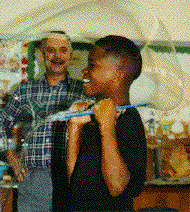 K-12 programs provide a critical starting point for encouraging minorities and women to pursue science
and engineering careers, since the pool of students interested in science and engineering at the graduate
and undergraduate levels is limited by the pool of students at the K-12 level. The following programs are
just a few examples of how the STCs are generating interest in science among women and
underrepresented minorities in K-12 schools.
K-12 programs provide a critical starting point for encouraging minorities and women to pursue science
and engineering careers, since the pool of students interested in science and engineering at the graduate
and undergraduate levels is limited by the pool of students at the K-12 level. The following programs are
just a few examples of how the STCs are generating interest in science among women and
underrepresented minorities in K-12 schools.
At the Center for Ultrafast Optical Science K-5 Science Camp, a student helps to demostrate concepts in diffraction, interference patterns, and surface tension. Other programs by the center are designed to help 8th grade girls, African-American students in grades 4-9, and Detroit area 7th and 8th grade minority students.
Elementary School Programs
Mentoring programs for minority children provide role models that encourage an interest in science. The Center for Synthesis, Growth, and Analysis of Electronic Materials launched the "Zavala Young Scientists" program in early 1992 with the "adoption" of a fourth grade class at Zavala Elementary School, a school in Austin, Texas with a large Mexican-American student population. The center sponsors field trips to the University of Texas and assists the teacher with hands-on activities and project materials. On field trips, pairs of children and graduate students or postdoctoral fellows share a 40-minute lab experience as "lab buddies." The program has grown to include the adoption of a pilot science-focused sixth grade class, support for other Zavala teachers in hands-on science programs, and development of a district-wide proposal for more science-focused elementary classrooms.Frequently, STC programs invite older students to participate in a variety of programs as mentors. At the Center for Superconductivity, two African-American undergraduate students promote after-school activities with children from the Kaseys Boys and Girls Club in Champaign, Illinois. The undergraduates help with after-school science activities and Saturday field trips and work with the research staff in developing science projects for the children. During a field trip to Argonne National Laboratory in 1993, the students performed data acquisition experiments, viewed demonstrations with cryogenic fluids, and toured several experimental facilities.
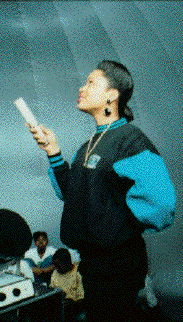 Each year at the Center for Magnetic Resonance Technology for Basic Biological Research, 500 children in
the Urbana-Champaign area participate weekly in two hours of hands on science instruction through
"Project SEARCH." The project addresses a diverse group of local-area students in grades K-6 and has a
specific program for underprivileged, mainly minority children at the Don Moyers Boys & Girls Club in
Urbana, Illinois, where 25 to 30 children take part in hands-on science activities each week. The success of
the SEARCH involvement with this after-school organization has resulted in the organization's
establishment of a "science room" as part of its new $1.1 million building. The new room will be part of
the club's effort to expand the scope of its activities. The Boys & Girls Clubs of America is currently the
fastest growing youth agency in the country.
Each year at the Center for Magnetic Resonance Technology for Basic Biological Research, 500 children in
the Urbana-Champaign area participate weekly in two hours of hands on science instruction through
"Project SEARCH." The project addresses a diverse group of local-area students in grades K-6 and has a
specific program for underprivileged, mainly minority children at the Don Moyers Boys & Girls Club in
Urbana, Illinois, where 25 to 30 children take part in hands-on science activities each week. The success of
the SEARCH involvement with this after-school organization has resulted in the organization's
establishment of a "science room" as part of its new $1.1 million building. The new room will be part of
the club's effort to expand the scope of its activities. The Boys & Girls Clubs of America is currently the
fastest growing youth agency in the country.
High school students in the "Space Explorers" program at the Center
for Astrophysical Research in Antarctica (see the following section on
secondary school programs) work with Adler Planetarium astronomers to
teach astronomy in grammar schools with the portable Starlab
planetarium. This small, inflatable planetarium can be set up rapidly
inside most schools.
A high school Space
Explorer teaching in a portable Starlab planetarium.
Starlab
presentations performed by the Space Explorers now reach nearly 3,000
minority students per year in the grammar schools that "feed into"
their high schools. The Space Explorers teach a sub-group of middle
school children all throughout the year. Like the programs mentioned
above, this initiative enables the older students to regenerate their
own interest in science while acting as mentors to the younger
children.
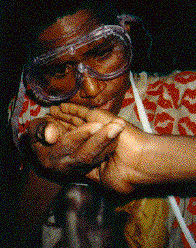 Secondary School Programs
Secondary School Programs
Programs for women and minorities at the middle school and high school
levels encourage students to consider careers in science and
engineering by giving them a look into what scientists and engineers
really do. To introduce children to basic science and engineering
principles, the Center for Synthesis, Growth, and Analysis of
Electronic Materials coordinates Project STEP, a middle school summer
science day camp. Seventy-six campers from the greater Austin area
enjoy two weeks of hands-on laboratory activities, computer workshops,
and skill-building games, plus career exploration and final projects.
Parents join their children for the last camp day and at three
follow-up meetings during the school year.Project STEP campers enjoy hand-on activies, such as how pillbugs respond to various environments.
Several high school programs for minorities further involve students in STC activities. The "Space Explorers" project at the Center for Astrophysical Research in Antarctica (CARA) provides an intimate environment through which the participating minority students and CARA scientists can interact. Each year, 30 African-American students from Chicago high schools come to the center to attend workshops and work at the laboratories. The project incorporates the hands-on use of the center's equipment, including research-quality telescopes at the Yerkes Observatory and amateur radios, for which students receive operating licenses to communicate to and run long-distance experiments with the center's South Pole site.
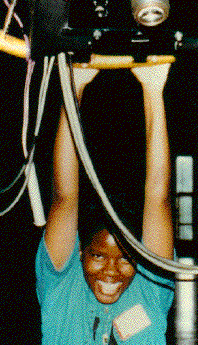 "Hands-on"
the largest telescope in the world at the Yerkes Observatory.
"Hands-on"
the largest telescope in the world at the Yerkes Observatory.
The
students even use household materials to take measurements such as the
size of the galaxy. By getting the students interested in space, the
project encourages them to broaden their scientific problem-solving
skills, to develop their communication skills, and to raise their
awareness of career options in science and engineering. The knowledge
they acquire can then be applied to their own science studies in high
school and college.
The Center for Microbial Ecology (CME) offers a comprehensive approach to hands-on science in its "Science in the City" program for two inner-city Detroit high schools. The CME conducts field trips for 20 African-American students to museums, pharmaceutical and chemical companies, hazardous waste landfills and treatment facilities, university research laboratories, biological stations, and state parks. In addition to the field trips, CME sponsors classroom-based activities and after-school presentations by CME faculty and graduate students, faculty from area universities, entomologists, endangered species specialists, and medical/dental practitioners. An after-school science writing program assists students in writing skills. Overall, the program gave students an in-depth look at the broad scope of microbial ecology. "I never knew so many beautiful things and places existed," commented one participating student who visited a biological station in rural Michigan. "In my neighborhood, kids just hang out and don't do anything. I never thought about going to college before, but now I want to do it."
In a program called "Back on Track," scientists at the Center for Particle Astrophysics, in collaboration with NASA, bring science to disadvantaged inner-city students. For many of the students, this program provides one of few opportunities for them to learn about and experiment with science. A highlight is the stargazing overnight field trip where, using the Center's "traveling telescope," the students view the stars highlighted in the program.
Some programs have focused on teachers at K-12 schools with a large percentage of underrepresented minorities. At the California Institute of Technology, the Center for Research on Parallel Computation (CRPC) hosts the Minorities Teachers Computational Science and Computer Graphics Awareness Program. This program, which is also supported by the Center for Computer Graphics and Scientific Visualization, brings high school teachers from Los Angeles and Pasadena-area schools with large minority enrollments to Caltech for a four-day session that introduces them to the most recent developments in the areas of concurrent computing, biotechnology, computer graphics and their applications and interconnections, and to the progress and opportunities in these fields. The information provided from these sessions has enabled teachers to motivate their students to consider opportunities in science and engineering fields. This program was modeled after the successful Mathematical Computational Sciences and Awareness workshop at Rice University, another CRPC site. Follow-up activities have shown a continued interest from teachers in programs of this nature.
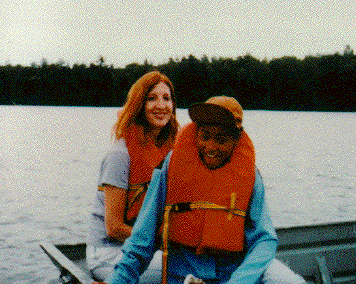 The use of scientists as role models has been highly effective in STC efforts that encourage female K-12
students. The goal of the "SummerScience for Girls" enrichment program at the Center for Ultrafast
Optical Science is to increase the self-esteem and confidence of 13- and 14-year-old girls and to reinforce
their interest in math and science. Herbert Winful, who has helped to organize the program at the
University of Michigan, added, "We want young girls to see that a career in science is a real option and
that they can go as far as they want to go." The girls are introduced to a research environment,
performing experiments such as making lasers, measuring the speed of light, and making holograms. The
female and minority researchers who work with the students help to eliminate any gender or racial
stereotypes that the students may have about scientists.
The use of scientists as role models has been highly effective in STC efforts that encourage female K-12
students. The goal of the "SummerScience for Girls" enrichment program at the Center for Ultrafast
Optical Science is to increase the self-esteem and confidence of 13- and 14-year-old girls and to reinforce
their interest in math and science. Herbert Winful, who has helped to organize the program at the
University of Michigan, added, "We want young girls to see that a career in science is a real option and
that they can go as far as they want to go." The girls are introduced to a research environment,
performing experiments such as making lasers, measuring the speed of light, and making holograms. The
female and minority researchers who work with the students help to eliminate any gender or racial
stereotypes that the students may have about scientists.
Another STC program held a national conference that explored the many opportunities and career options available to women in science. In 1993, the Center for Superconductivity and Argonne National Laboratory sponsored the "Science Careers in Search of Women" conference, where female high school students listened to talks and panels given by female scientists from several scientific disciplines. A special focus was placed on employment trends and educational requirements.
Undergraduate Programs for Underrepresented Minorities and Women
At the undergraduate level, women and underrepresented minority students are given research opportunities at many STCs. Each program provides a supportive environment that encourages these students to pursue a career or advanced study in science, engineering, or mathematics.The "Spend a Summer with a Scientist" program was initiated by Richard Tapia of the Center for Research on Parallel Computation in 1989 with this goal in mind. Minority students spend the summer at Rice University and the Baylor College of Medicine, working with faculty mentors on computational science projects. As Tapia notes of this program, "It has created a community where undergraduates, graduate students, research scientists, and faculty support each other in their research projects and professional goals. As a result, the program is measured not only in the number and types of research projects completed by the students, but in the personal experiences and confidence they have gained as well."
The Center for Discrete Mathematics and Computer Science (DIMACS) has provided educational support for the "AT&T Bell Labs/Bellcore Summer Training Program for Women and Minority Students." Since 1989, DIMACS has provided participants with computing courses, career counseling, and software tools for research.
The Rutgers Young Scholars Program in Discrete Mathematics, which provides students with unique research opportunities, is sponsored in part by the Center for Discrete Mathematics and Theoretical Computer Science.
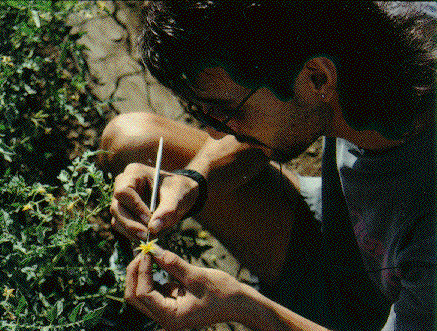 One STC initiative placed a special emphasis on involving Native
Americans in research activities. At
the Center for Engineering Plants for Resistance Against Pathogens
(CEPRAP), a Native American undergraduate from DQ-University worked
for one summer with a center researcher on exploring the role of
plasmodesmata in the inter-cellular mobility of plant viruses.
The student worked one-on-one with CEPRAP researchers, enhancing his
knowledge of plant biotechnology. It is important to note that the
success of this student encouraged a second Native American student
who worked at CEPRAP the following year. Working alongside the
original intern, who completed a second year of internship, the second
student (who was female) also achieved great success and continued to
work at CEPRAP after the internship as a paid student research
assistant.
One STC initiative placed a special emphasis on involving Native
Americans in research activities. At
the Center for Engineering Plants for Resistance Against Pathogens
(CEPRAP), a Native American undergraduate from DQ-University worked
for one summer with a center researcher on exploring the role of
plasmodesmata in the inter-cellular mobility of plant viruses.
The student worked one-on-one with CEPRAP researchers, enhancing his
knowledge of plant biotechnology. It is important to note that the
success of this student encouraged a second Native American student
who worked at CEPRAP the following year. Working alongside the
original intern, who completed a second year of internship, the second
student (who was female) also achieved great success and continued to
work at CEPRAP after the internship as a paid student research
assistant.
Many STCs have summer internship programs. The Center for Microbial Ecology (CME) conducts a summer research internship program for college juniors and seniors based on CME interests in tropical microbial ecology. CME has focused on students from the University of Puerto Rico campuses to participate in this program. The students work one-on-one in laboratories with CME researchers. As a result of the summer internships, a collective effort has developed between CME faculty and the three major universities in Puerto Rico including the University of Puerto Rico at Mayaguez, the University of Puerto Rico at Rio Piedros, and Humacao College. This effort involves not only summer internships but CME Annual Forum attendance, three-day CME lectureships in Puerto Rico, and ongoing joint research projects. Based on mutual efforts in biotechnology areas, CME conducted a two-day workshop for undergraduates in the Spring of 1994 at Humacao College.
In addition to academic excellence, bringing a diverse group of undergraduates to the Center for Particle Astrophysics "Summer Outreach Program" is an important center priority. Dennis Lamenti, a 1993 program participant, says of his experience, "At first I believed that I was just their token Native American, but as I grew to know these people, I felt their conviction and their responsibility toward other human beings, just as I know of my own responsibility to my own people, the Dine...The center and I have the same aspirations, to learn and then to share what we have learned with others..."
Collaborations with Historically Black Colleges and Universities
STCs have been particularly effective in encouraging African-American undergraduates by establishing linkages with Historically Black Colleges and Universities (HBCUs). These linkages are important because they help to reach the significant portion of African-American undergraduates who are found at HBCUs.- Thanks to a supplemental grant from the NSF, the Center for Superconductivity was able to expand its summer research program in 1993 to target more prospective young scientists from Clark-Atlanta University, Florida A&M University, Jackson State University, and Chicago State University.
- The Center for Molecular Biotechnology's Summer Undergraduate Research Program (SURE) is an 8-12 week program where students participate in laboratory research and attend a series of lectures. SURE students are recruited via extensive mailings to schools with MARC (Minority Access to Research Careers) programs.
- The Center for High Performance Polymeric Adhesives and Composites supports collaborative work between center staff and faculty and students at Clark Atlanta University and the Hampton Institute.
- Argonne National Laboratory, one of the sites of the Center for Research on Parallel Computation, is helping to bring parallel computing courses twice a year to more than 54 HBCUs with its own course in parallel computing for faculty. These week-long courses introduce faculty to parallel machines and programming, giving them access to these machines during the program and for up to a semester afterward. The knowledge they gain from these courses can then be used to prepare courses to train undergraduates in the use of parallel computing. The need for this program has become greater as the use of parallel computers has increased in science and engineering.
- The Center for Photoinduced Charge Transfer hosts sabbaticals for HBCU faculty, who participate in the center's research. The aim of the program is to establish a cooperative research relationship that will provide opportunities for college faculty and students to continue the research programs on their own campuses during the regular school year and at the University of Rochester during the summer.
- The Center for Advanced Cement-Based Materials (ACBM) has developed a partnership with Howard University with a goal of establishing a research program there. Through the program, center faculty visit Howard University, assisting students with research projects. The students, who are working on M.S. degrees, are strongly encouraged to pursue a Ph.D. at one of the four ACBM-affiliated universities. The program also provides students the opportunity to work on a research project over the summer at Northwestern University.
- With the encouragement of the United Negro College Fund, the Center for Research in Cognitive Science is working with faculty from eight HBCUs to develop cognitive science curricula at these institutions for students who might not ordinarily be exposed to cognitive science. This, in turn, may bring a more diverse population into careers related to cognitive science and its affiliated disciplines, such as mathematics, science, and engineering. Through a planning grant from the James S. McDonnell Foundation, the center is working with faculty at Clark Atlanta University, Fisk University, Morehouse College, Oakwood College, St. Augustine's College, Spellman College, Talladega College, and Tuskegee University. Faculty from these schools are introduced to topics related to cognitive science and discuss with center faculty how these topics can be implemented into their curricula.
- The Center for Ultrafast Optical Science maintains relationships with Hampton University in Virginia and Alabama A&M University. Exchange programs involving faculty, undergraduates, and graduate students range from single seminars to research visits of several weeks. As part of this collaboration, the three universities provide faculty members to serve on each other's advisory boards.
Educational Efforts in Cultural Diversity for Educators at All Levels
Some STC programs address the science education community as a whole to deal with problems and issues that are wide in scope. One such example is the "In Balance" program sponsored by the Center for Particle Astrophysics, where the scope of education is broadened beyond scientific training. "In Balance" provides the knowledge and skills needed to foster a productive, welcoming environment in which diversity is a community goal. A series of workshops, meetings, and retreats provides a forum for discussion of the issues in the culture of science, such as unhealthy levels of competition, sexual stereotyping, the "glass ceiling," and balancing career and family. Through this program, faculty, graduate students, postdoctorates, and staff receive training in effective communication, cultural awareness, and management skills. By enhancing the ability for successful interactions between researchers, administrators, and students, the program generates a fertile ground for success. Director Bernard Sadoulet said of the program, "Particularly in the participation of students, the program has significantly modified our research atmosphere, with more open interpersonal relations, greater initiative on the part of group members, and greater ability by members to face conflicts and technical crises. With "In Balance," we're training scientists who are more balanced and more in tune with our diverse society."To delve further into the cultural issues of science initiated by "In Balance," the center hosted a conference called "Changing the Culture in Science" in June of 1992. Sponsored by the center and four other STCs (the Center for Astrophysical Research in Antarctica, the Center for Molecular Biotechnology, the Center for Quantized Electronic Structures, and the Center for Research on Parallel Computation) the conference featured several distinguished scientists, including Nobel Prize-winning physicist Leon Lederman. More than 120 faculty members, students, postdoctorates, and administrators came to the conference to "chart a new course" in science. Walter Massey, then director of the NSF, commented on the importance of this meeting when he said, "I've been to a number of conferences in my career on how to increase participation in science and engineering. Most start with the thesis that we need to figure out how to get more underrepresented groups into the system, as if the system itself were some pre-existing entity ordained by God. This conference is saying, 'Let's look at it in a broader way...let's look at what the system is and how it needs to change and adapt to who the people are."
Table of Contents
Sites & Affiliations | Leadership | Research & Applications | Major Accomplishments | FAQ | Search | Knowledge & Technology Transfer | Calendar of Events | Education & Outreach | Media Resources | Technical Reports & Publications | Parallel Computing Research Quarterly Newsletter | News Archives | Contact Information
| Hipersoft | CRPC |
© 2003 Rice University
|